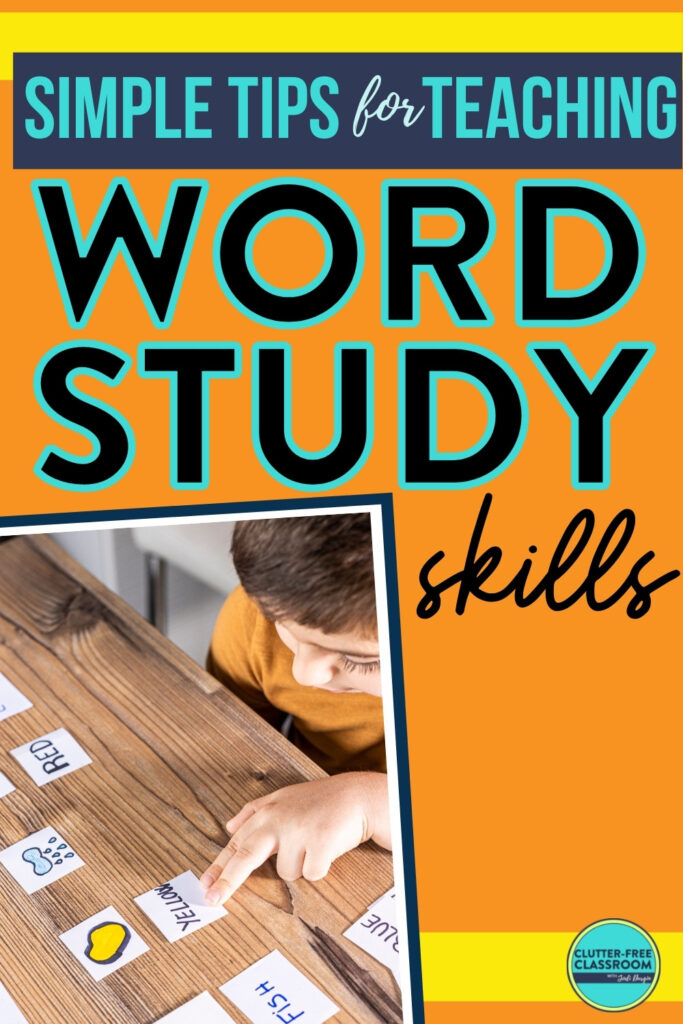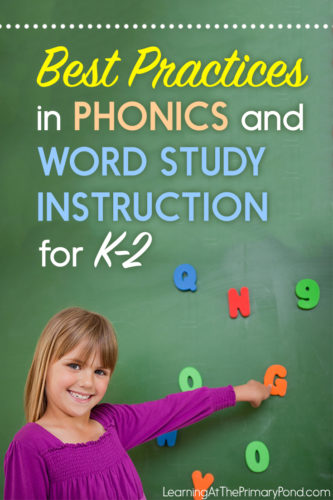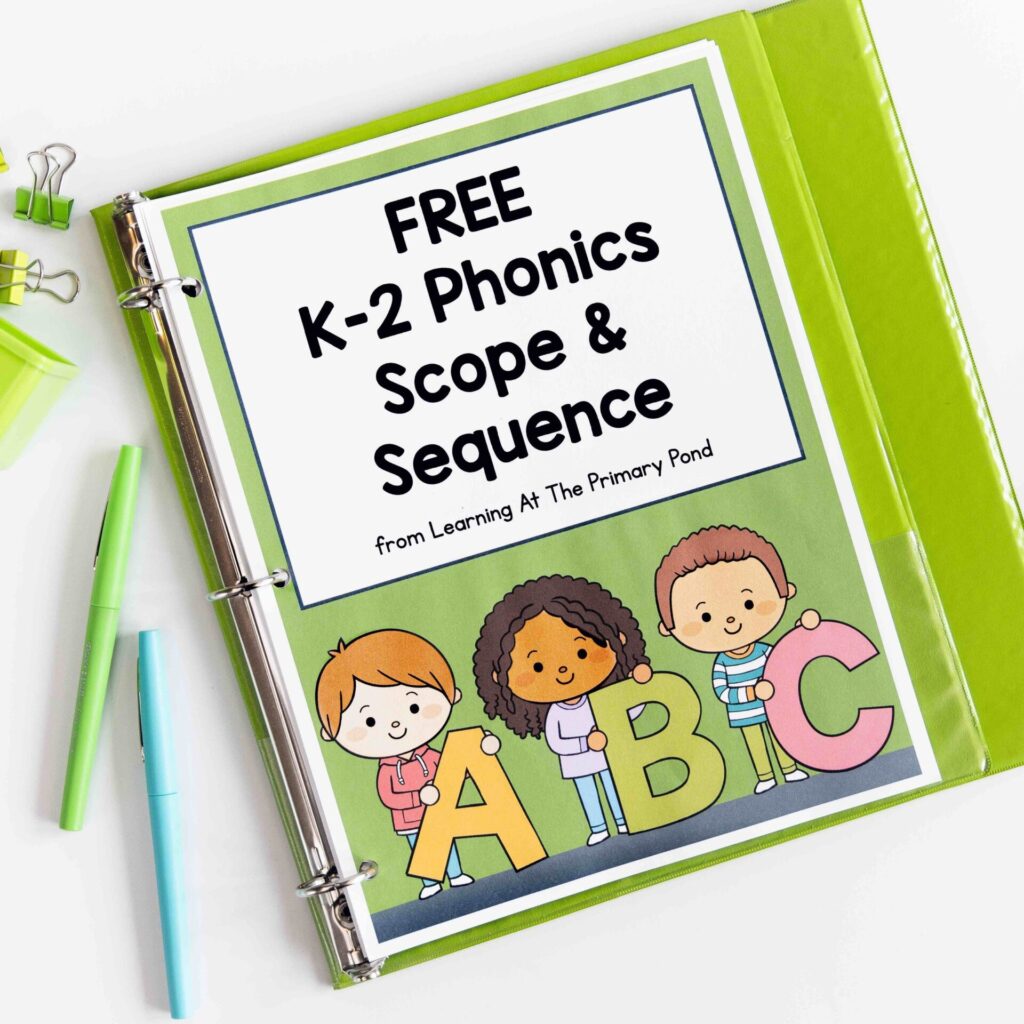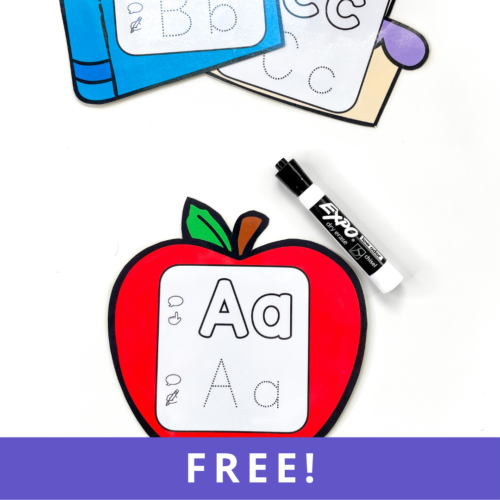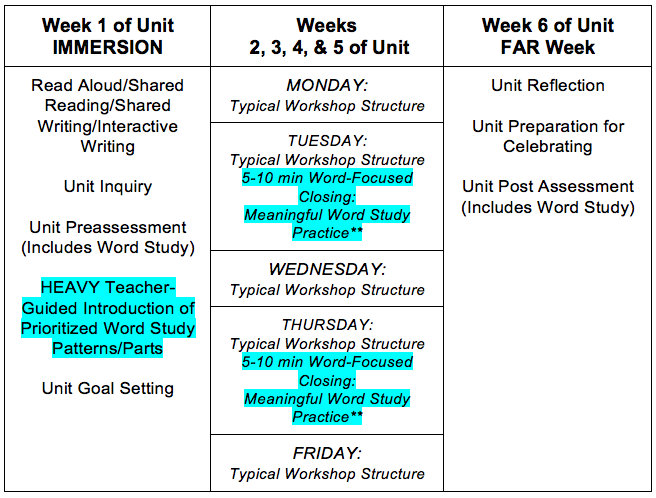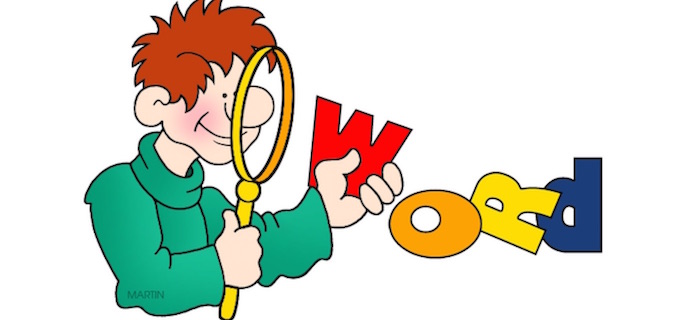( words) Estimated Read Time: minutes remaining
A quick research review for word study can answer very important questions about literacy curriculum and instruction in our schools.
- What does the research say about the use of word study?
- What type of word study instruction is effective in upper elementary and middle school?
- What are the purposes and effects of teaching word knowledge to transitional readers?
In this article, you will find a quick research review for word study. The studies include these topics:
- Phoneme awareness predicts reading comprehension.
- Using phoneme-grapheme mapping in reading instruction.
- What is the effectiveness of computer-assisted reading interventions?
- Middle school word study that works, and doesn’t.
Quick Research Review for Word Study
1. Phoneme Awareness and Reading Comprehension
An intervention in spelling, reading comprehension, reading speed, and phoneme awareness was administered to 112 nine-year-old students with reading challenges. The students previously showed a lack of response to intervention in the area of reading speed.
The reading intervention in this research article explicitly taught decoding skills and reading speed. It also included comprehension and spelling strategies, but it focused on phonics.
The results?
Immediately after the intervention, the students improved in measurements of spelling, reading comprehension, reading speed, and phoneme awareness.
More importantly, this intensive word study intervention produced long-term gains.
A year after the intervention, students were re-assessed. They continued to show strong improvements in spelling, reading comprehension, reading speed, and phoneme awareness.
Wolff, Ulrika (2011). Effects of a randomized reading interventions study: An application of structural equation modelling. Dyslexia 17(4), 295-311.
http://onlinelibrary.wiley.com/doi/10.1002/dys.438/full
2. Using Phoneme-Grapheme Mapping
Graphemes are the letters, the spelling. Phonemes are the units of sound. For exmaple, ch is made of two graphemes — c and h. But it makes one phoneme — the /ch/ sound.
This article analyzed the phoneme-grapheme mappings that oocur in monosyllabic English words.
The author suggests that reading instruction in phoneme-grapheme patterns can benefit students when the most useful phoneme patterns are taught. Students can use the patterns to decode many different texts.
Vousden, J.I. (2007). Units of English spelling-to-sound mapping: A rational approach to reading instruction. Applied Cognitive Psychology 22(2), 247-272.
http://onlinelibrary.wiley.com/doi/10.1002/acp.1371/full
3. Effects of Computer-Assisted Reading Instruction
Two distinct reading programs were evaluated against a control group for a period of 12 weeks with 5 sessions per week.
The computer programs used games that focuses on graphemes, phonemes, and rimes. Both computer assisted reading interventions produced gains in reading, spelling, and phonological skills compared the control (non-computer) group.
The student groups were re-assessed four months after the intervention ended. They continued to show gains over the control group.
Kyle, F., Kujala, J., Richardson, U., Lyytinen, H., & Goswami, U. (2013). Assessing the effectiveness of two theoretically motivated computer-assisted reading interventions in the United Kingdom: GG Rime and GG Phoneme. Reading Research Quarterly 48(1), 61-76.
http://onlinelibrary.wiley.com/doi/10.1002/rrq.038/full
This review of research for word study doesn’t have the scope for including other studies, but I recommend also: Effects of Education Technology Applications for Struggling Readers.
4. Middle School Word Study that Works
This non-journal research article presents a school-level experimental study involving 24 schools over three years. It analyzed the impact of a research-based vocabulary program, Word Generation, in grades 4-8.
What does the program do?
It introduced five highly leveraged academic words per week. Students examined and discussed topics around these five words in all academic areas daily. There were also reading and writing tasks, but the program was based on the idea that discussion builds knowledge.
Each week, students also read an academic-style text with the five words in it. And they wrote one «taking a stand» paragraph at the end of each week using the five words.
The results?
The students at grades 4, 5, 6, and 7 demonstrated significant increase in vocabulary knowledge after one year of the intervention.
After two years of the intervention, students in the intervention schools demonstrated increases above the control groups in vocabulary and these areas:
- Taking different perspectives
- Use of academic language
- Deep reading comprehension
Jones, S.M., Kim, J., LaRusso, M., Kim, H.Y., et al. (2016). Experimental effects of word generation on vocabulary, academic language, and perspective taking in high poverty middle schools. Society for Research on Educational Effectiveness.
https://eric.ed.gov/?id=ED567007
Research Review for Word Study Conclusions
The four research articles provide evidence that word study is an important component of elementary and middle school literacy and academic curricula.
There were a few common threads in this research review. Word study best practices include:
- Intensive daily instruction in word recognition skills for struggling readers.
- Phoneme-grapheme mapping.
- Explicit instruction and practice in reading speed.
- Academic conversations and writing around key words.
- Use of high-utility academic words.
Looking for a Word Study Program?
TeamTom Education offers free Word Study Warm-Ups for grades 2-8.
Today, you can begin building stronger readers and writers at
spiralwarmups.com!
This free program aligns with the recommendations from this Research Review for Word Study.
Matt is a learner, creator, and educator with k-12 teaching, administrative, and research experience. He tracks trends in education, travels the oceans, and fails at fishing.
Related Reading
- February 17, 2018
Phonics instruction (or word study, or word work) is an important component of literacy instruction.
But as you probably already know, it’s such a complex thing to teach! Questions come up, like…
- How do you figure out what kids need to work on?
- What’s the best way to address different students’ levels?
- How do you differentiate when your students are at SO many different levels?
- Which activities are most effective for getting kids to actually REMEMBER words and word patterns?
- How can you keep activities fresh without spending every waking moment making materials?!
It’s a lot to think about!
Over the next weeks and months, I’ll try to address all of these questions and more – through blog posts, videos, resources, and webinars.
I thought that a good starting point would be to share some general best practices for teaching phonics or word study. Understanding these concepts will help you make sense of the blog posts and freebies that I’ll share with you over the following weeks!
My goal was to take a lot of information and synthesize it into a format that is (hopefully) easy-to-understand and applicable!
But before we dive in, a couple of Q and As! 🙂
What grade levels is this appropriate for?
Most of my own teaching experience is in K-2, so these are the grade levels that this post focuses on. These same principles apply to the older elementary grades, however.
What resources did you use to write this post?
I used parts of Best Practices in Literacy Instruction (Morrow & Gambrell), Words Their Way (Bear, Invernizzi, Templeton, & Johnston), Rethinking Phonics (Dahl, Scharer, Lawson, & Grogan), A Fresh Look at Phonics, Grades K-2 (Blevins), and several different articles from the Reading Teacher journal. You can check out my bibliography at the end if you’re interested in learning more!
Should I change my instruction if it doesn’t reflect these best practices?
Research indicates that following these best practices will lead to improved student outcomes – so making changes will be helpful to your students!
At the same time, keep in mind that the research I’ve included here doesn’t tell the whole story. Any research can be biased or flawed. Studies can contradict each other. Sometimes there’s a gap between research and actual classroom practice.
That said, I’ve done my best to gather resources that are trustworthy and peer-reviewed. I’ve used the principles in this post in my own teaching, and I’ve seen that they work.
I hope that this information will be helpful to you!
Photo Credits; wavebreakmedia, Shutterstock
Principle #1: There is no one best way to teach phonics. But however you teach it, phonics instruction should be systematic and explicit.
- Systematic means that we progress through a specific scope and sequence. For example, if students are ready to learn short vowel word families, we don’t teach miscellaneous word families as they appear in our shared reading stories. We have a plan to teach the -at word family, then -an, etc. It also means that instruction goes from easy to complex and includes built-in review and repetition (Blevins, 2017).
- Explicit means that we have to directly teach students about letters, words, and spelling patterns. We use thinkalouds and clear language so that students gain strategies for reading and writing words. Although we can encourage students to make their own discoveries about words, we don’t expect them to do it on their own.
- Word work can’t simply be assigned as independent work. Although independent practice is important, the instruction you provide students is essential: “Word study…offers valuable opportunities for students to be actively involved in making discoveries about the spelling system and developing vocabulary, but only if teachers facilitate group discussions that foster thoughtful interactions (Gehsmann, Millwood, & Bear, 2012, cited on p. 59 of Words Their Way, Bear, Invernizzi, Templeton, & Johnston).
If you’re in need of a K-2 scope and sequence that is systematic and explicit, click here for my FREE resource.
Principle #2: Phonics instruction should take place OUT of context (i.e. phonics-focused lessons), as well as IN the context of real reading and writing activities.
- When you are reading and writing with students, this is a great time to discuss and teach them about words. BUT this in-context practice is not sufficient.
- Students need dedicated instruction and a specific time in the school day to learn about letters and words.
- Learning phonics and spelling is part of becoming a good reader. When students read, they learn how to spell words. When students learn to spell words, this helps them with their reading.
- Even when we have a dedicated phonics or word study time, it’s still important to show students how to apply those concepts and notice words in context. Shared reading is a great opportunity to discuss letters and words, because students can see the text clearly. But discussions don’t have to be lengthy, especially if your lesson has a different focus. For example, if you come across a word with the short a sound and many students have been studying it, you might point to the word and say, “This word has a short a sound, doesn’t it? How do we say that letter sound? (/a/) Do you see any other short a words on this page?” (This is just one example – there are many more ways to help students notice and apply phonics learning in context.)
- Students’ independent work can be a combination of out-of-context and in-context activities. Students may be reading and sorting words, but they should also have a chance to find words with that specific pattern in real texts, and even their own writing.
- Here’s a good quote from Words Their Way: “The best way to develop fast and accurate recognition and production of words is to engage in meaningful reading and writing, and to have multiple opportunities to examine those same words and their features in and out of context” (Bear, Invernizzi, Templeton, & Johnston, p. 5).
Principle #3: Phonics knowledge is developmental. Students may develop at different rates, but they generally follow the same trajectory or sequence of learning.
- When kids are learning to spell in English, they typically learn to master letter sounds and word patterns in a predictable order (beginning with initial consonants, then final consonants, then short vowels, digraphs, blends, long vowels, etc.).
- Even when students have learning delays or disabilities, their progress still follows this predictable order – they just move through the developmental stages more slowly.
Principle #4: In order to be most effective, phonics instruction needs to be differentiated, so that it matches the specific level of the learners. This includes beginning letter sound instruction.
- Figuring out our students’ levels starts with a good assessment.
- A spelling inventory is a great way to assess students’ phonics and spelling knowledge. In a spelling inventory, you have students spell various words, and the words increase in difficulty. Then, you analyze their work to see what word features they have mastered and what features they are still working on.
- Words Their Way has several spelling inventories that I highly recommend. Other options include the Kindergarten Spelling Inventory, McGuffey Spelling Inventory, and Viise’s Word Feature Inventory (search for these online).
- Once we analyze students’ spelling, we can group students based on their abilities and differentiate our instruction for maximum results: “When students are taught at their instructional levels in spelling…they will make more progress than with materials that are too difficult for them” (Morris, Blanton, Blanton, Nowacek, and Perney, 1995, cited on p. 35 of Words Their Way, Bear, Invernizzi, Templeton, & Johnston).
- If you’ve heard of Vygotsky’s Zone of Proximal Development, that is exactly what we want to target with our word study instruction. We want to teach our students to master word features that they are currently “using but confusing” (Bear, Invernizzi, Templeton, & Johnston, 2015). For example, if a child is attempting to spell “bike” by writing “biik,” she is trying to use a long vowel spelling pattern. This might be a concept that she is ready to learn next.
- Although students may have a wide range of abilities, it’s best to teach phonics or word work in small groups: “Small group instruction…has been demonstrated to be more effective than whole-class or even one-to-one instruction in supporting young children’s early literacy development (Connor et al., 2006; Ehri et al., 2001)” (Piasta, 2014).
Even if students are at slightly different stages of development, it’s much more practical to have 3 or 4 groups than it is to have 10 groups. - Because students enter school with varying levels of letter knowledge, the principle of differentiation applies to letter sound learning, too. “Teachers get the best results when differentiating small-group instruction in response to the students’ existing alphabet knowledge” (Stahl, 2014, p. 262).
- When it comes to letter sound learning, I do like to (quickly) cover each letter in a whole group setting at the beginning of Kindergarten. At this point in the school year, the kids aren’t ready to do a ton of independent work. Once I’ve covered all of the letters (several each week) with the entire group, then follow-up instruction takes place in small groups.
I’ll share more ideas about organizing small group instruction in an upcoming post!
Principle #5: When working with a class of students who are learning their letters, it’s more effective to cover letters quickly (and loop back for review) than it is to teach one letter each week.
- Multiple studies have shown that students learn letters more quickly when taught a letter a day instead of a letter each week. (My own preference is to do 3-4 letters per week.)
- Once students have been exposed to all letters, you can then loop back and review. I like to do this review in a small group setting (see Principle #4).
- Use assessment data to group students for alphabet / letter sound instruction. The groups may not be 100% perfect matches, but you will still be able to target your instruction much better than if you relied only on whole-class lessons.
If you’re in need of a FREE resource for multisensory phonics centers that work on alphabet letters, click here for that freebie!
Principle #6: Students need to be taught to generalize spelling patterns.
- Traditional spelling tests (like the ones I took growing up!) have students memorize specific words. And students often forget those words immediately after the spelling test is over! It’s more effective to focus on word features or patterns that students can use to read and spell many different words. I think of this as learning about words as opposed to just learning WORDS.
- Although you may designate a set of words that students are working on for a week, it’s also important to have them practice using those spelling pattern(s) to read and write new, additional words.
Principle #7: Word study activities that emphasize PATTERNS rather than COPYING are most effective.
- There are many exceptions in the English language, but there are also many patterns. According to Blevins (2017), 84-87% of English words follow consistent sound-spelling patterns. And the human brain loves patterns! We can capitalize upon this by designing activities that focus on word pattern learning and application, rather than rote copying.
- For example, an activity like rainbow writing words is less effective than an activity where students have to sort and write words into categories based upon their features. The second activity requires more thinking, and therefore increases the chance that students are attending to the word features and learning the words, too!
- A good quote from Words Their Way: “There are many long-standing activities associated with spelling such as writing words five times, using them in alphabetical order, and copying definitions from the dictionary. Assignments like these do not fulfill the purpose of spelling instruction, which is to not only learn the spellings of particular words but also to understand generalizations about the spelling system itself and to cultivate a curiosity about words. Writing a word five times is a rote, meaningless, and ineffective activity (Templeton & Morris, 2000), whereas writing words into categories requires recognizing common spelling features and using judgment and critical thinking. Writing words in alphabetical order may teach alphabetization, but it will not teach anything about spelling patterns” (Bear, Invernizzi, Templeton, & Johnston, 2015).
Principle #8: Word study activities should be completed with words that students can already read.
- When students move beyond letter sounds and are working with words, they should practice phonics and spelling with words that they can already read. Otherwise, they end up not reading the words as they work independently. Activities then become rote and less meaningful.
- If you use word sorts, simply discard words that students can’t yet read. You can always put them back in in the future.
Conclusions
Phew, that was a lot! Thanks for hanging with me! 🙂
Did you read anything in here that really resonated with you? Do you plan to make any changes to your classroom instruction? Let me know in a comment!
As I wrote at the beginning of this post, I’ll be sharing ideas, activities, and freebies for phonics instruction and word work over the next few weeks. Check back each Saturday for a new post! Happy teaching!
Bibliography
Bear, D. R., Invernizzi, M., Templeton, S., & Johnston, F. (2015). Words Their Way: Word Study for Phonics, Vocabulary, and Spelling Instruction (6th ed.). Pearson.
Blevins, W. (2017). A Fresh Look at Phonics, Grades K-2. Thousand Oaks, CA: Corwin.
Daffern, T. (2017). What Happens When a Teacher Uses Metalanguage to Teach Spelling? The Reading Teacher, 70(4), 423–434.
Dahl, K. L., Scharer, P. L., Lawson, L. L., & Grogan, P. R. (2001). Rethinking Phonics. Portsmouth, NH: Heinemann.
Ganske, K. (2016). SAIL: A Framework for Promoting Next-Generation Word Study. The Reading Teacher, 70(3), 337–346.
Morrow, L. M., & Gambrell, L. B. (Eds.). (2011). Best Practices in Literacy Instruction, Fourth Edition. New York, NY: Guilford Press.
Piasta, Shayne B. 2014. “Moving to Assessment-Guided Differentiated Instruction to Support Young Children’s Alphabet Knowledge.” The Reading Teacher 68 (3): 202-211.
Reutzel, D. R.. (2015). Early Literacy Research: Findings Primary-Grade Teachers Will Want to Know. The Reading Teacher, 69(1), 14–24.
Stahl, K. K. (2014). New insights about letter learning. Reading Teacher, 68(4), 261-265.
Related Posts:
Alison
Inline Feedbacks
View all comments
Along with your English scope and sequence could you recommend a Spanish scope and sequence?
Thanks! This reiterated to me what I’ve already believed and tried to do. I struggle with the implementation and logistics of the differentiated groups and time to plan specific activities for each level. Looking forward to your tips.
Reply to Bev
Hey Bev! I’m glad this was a good review – check back this coming Saturday for more about small group logistics. 🙂
Alison
Thanks Alison I appreciate your hard work and sharing so much with other teachers!
Reply to April Crout
You’re so welcome, April! Thanks for reading!!
Alison
Some great reminders and some great new tips! Really appreciate this post! Thanks!
Reply to Kate
Glad it was helpful, Kate! Thanks for reading and commenting!
Alison
All great information. Thank you. I’m beginning to change my approach during my reading block and this is definitely food for thought.
Reply to Cheryl
So glad this was helpful, Cheryl!
Alison
Donald Knight
5 years ago
A super article. What resonated with me was the point you made about patterns.
Reply to Donald Knight
Thank you so much – glad this resonated with you!
Alison
Thank you Alison! Every suggestion and resource that you have given me in reading and writing has worked beautifully in my classroom, and I’m SO excited to be learning Phonics/word work instruction from you!! I’ve been struggling for several years about the very questions you have cited in this post – I will be reading everything and getting ready to ramp up my phonics instruction with my 2nd graders next year. Thank you so much for sharing this things with us!!!
Reply to Jana Tutor
You’re so welcome, Jana! Thank you for reading and for your sweet comment!!
Alison
Hi Alison! Thanks so much for all you do! I’m a new teacher and I’ve read so much and gathered so much material prior to actually beginning to teach and a lot of it was based on the teachings/researched philosophies of Blevins. This is only because my graduate program required her literature. I have since found that following the guidelines and requirements of my district and/or administrators makes it impossible to implement targeted instruction in phonics and writing. Please help me figure out a way to navigate this area so that I can help my students be as successful as… Read more »
Reply to Renea
Hey Renea! I have been in the same situation with tricky district requirements. Please feel free to email me if I can be of further help!
Alison
This as a fantastic review. Thank you for the references.
Thank you. I knew this information but having a refresher is always welcome. I am really looking forward to your future posts about making groups and what to teach in each group.
Penny Bonnington
5 years ago
I couldn’t agree more about the need to use and constantly revise spelling patterns! I say to my class that we are not learning spelling – we are learning HOW to spell!
Reply to Penny Bonnington
Lisa Marynowski
5 years ago
Allison,
I always appreciate your dedication to helping us all be the best teachers we can be. You remind us of so many things we should be doing to help our students.
Thanks,
Lisa
Reply to Lisa Marynowski
Thanks, Lisa – so glad it’s helpful!! I appreciate your sweet comment!
Alison
Great read! I like your point about students not reading the words and the activities becoming rote and meaningless. Thank you for your dedication to teachers and students.
I love how this information was so thorough and made perfect sense. I too struggle with the logistics or getting my groups rolling and organizing sequential activities for each group. Looking forward to more guidance! Thanks so much!
Michaela Patel
5 years ago
Hi Alison, This is interesting. Thanks for sharing. It’s so hard to choose spelling approaches: each one of the programs you mentioned, and all the ones I’ve seen in Australia, are all written by highly knowledgable people with PhDs and extensive experience in literacy. They also have different philosophies and ideas that they are keen to push, so it’s hard to filter out what is really going to work, and what won’t. We did a whole school PD (Professional Development) day last week on spelling, with a lady called Michelle Hutchinson who has developed a program called SMART spelling. I’ve… Read more »
Reply to Michaela Patel
Hey Michaela! Thank you for sharing this – I just love learning about different ways of teaching phonics! I’m curious to hear how you like the approach throughout the school year!
Alison
Reply to Michaela Patel
Michaela,
Were you happy using SMART for the rest of the school year?
Yes, Yes, Thank you. Have ordered a copy of the book ‘Words their Way’ as am interested in assessment. Perfect timing, having started with an all class phonics program that doesn’t seem enough I am looking for new ideas.
Reply to Jo Cameron
Awesome – I hope you love the book! It’s a lot to read through at first, but 110% worth it!
Alison
Great article! Patterns! This is so important! That is why we need to adapt things like “Rainbow Write” to color coding the “patterns” or “pattern” only instead of randomly coloring each letter with a different color. Have the students use pencil for the rest of the word. I actually do the “sort and write words into categories” every week with their new list of words. I use a site called “Free Printable Flashcard Maker” to quickly make “sort cards and generate title pattern cards” to go with our Pearson Reading Street curriculum. I differentiate by using Words Their Way Sorts… Read more »
Reply to Wendy Genzel
That’s awesome Wendy – I have not heard of that site! Thank you for sharing!!
Alison
I absolutely learned a lot! Thank you for sharing your ideas!
Thanks so much Alison! Do you use a specific teaching order for introducing letters in Kindergarten?
Reply to Emily
Hey Emily! I have pieced things together here and there, but Wiley Blevins has a sequence in his book A Fresh Look at Phonics that I plan to follow from now on, more or less. The book is on Amazon if you’re interested! 🙂
Alison
Christina Courtny
5 years ago
Allison,
I love your blog. I love everything you suggest!! I have been struggling with why my first graders are not making the growth needed this year and I believe it is because I am not dedicating enough time to word study and direct explicit phonics instruction. I am big fan of Wiley Blevins and just re-read his book I own. I have been using Jan Richardson’s Next Step in Guided Reading template and am going to include word study daily (the templates do not do daily word study). Anyways, thanks again for helping me reach my students!
Reply to Christina Courtny
Hey Christina! Thanks so much for reading! Those sound like awesome next steps for your firsties – and those are both such good books. Let me know how it goes!
Alison
I stumbled upon your blog when looking for a resource for a class I am taking! You have great ideas, and I just sent the link to your blog to a couple of my colleagues. I think your ideas will be so helpful to us as we plan out next school year. Thanks!
Reply to Karen
Hey Karen! Thank you so much – I’m glad the posts are helpful to you! Thanks for reading!! 🙂
Alison
Casey Schultz
4 years ago
Hi!
I very much agree with and appreciate all of the best practices you shared. I might have missed this, but didn’t notice any mention of phonological awareness (more of a focus on letter and sound identification and then spelling patterns). I’m wondering when and where in your schedule you suggest teaching phonological awareness (e.g., rhyming and syllable identification in kinder, phonemic segmentation and blending, phoneme deletion, etc, later on).
Thanks!
Reply to Casey Schultz
Hey Casey! I usually do those activities as transitions, between one activity and the next. So I sneak them in all throughout the day. I try to involve movement when I can, too! 🙂
Alison
Love this so much! I was wondering if you have an order or sequential list of the word patterns that you teach?
Reply to Rhiannon
Hey Rhiannon! I have used Words Their Way in the past for a sequence. 🙂
Alison
Alison – I appreciated all of your insight on teaching phonics. I am enrolled in a reading class and have just completed tutoring sessions with a struggling first grade reader. He is very aware of all letter sounds and has a moderate level of decoding skills of CVC words. We have been working on that skill and on consonant blends. After a few activities it was clear that he is struggling with consonant blends that end in ‘r’. He had mastered the blends that ended in harder sounds like ‘k’ or ‘t’. What type of activities would you recommend that… Read more »
Reply to Jennifer L
Hi Jennifer! With the r-blends, could it be an issue of articulation difficulties or phonological difficulties? Can he isolate the two sounds if you say a blend out loud? Feel free to email me so we can discuss further. 🙂
Alison
Hi Alison!
Thanks for writing this post! I always come to you when I am lacking inspiration or ideas. This particular post helped me refocus my phonics teaching and get ready for the week.
Reply to Taylor
I’m so glad, Taylor!! Thanks for reading!
Alison
Your posts are so helpful! We have been using words their way in our first grade classrooms and now will be getting a phonics curriculum (I think Fundations). Should we discontinue WTW or would it make sense to do both? Thanks!
Reply to Randi Foust
Hey Randi! I haven’t worked extensively with Fundations (although I use the “sister” program, Wilson) but I do think that it makes sense to do both – your foundational phonics instruction AND word sorts. I think they’ll complement each other nicely, although you’ll probably have to spend less time on WTW. 🙂
Alison
Regarding Principle #7 – what (best) practice activities do you recommend for students to do independently to practice their word study features? Thank you for your time.
Reply to Amy
Hi Amy! You probably already use word sorts, but those are a big one I use! I also do word hunts where kids look for words with the target features in the context of real texts. For other activities and games, I look for things that have the kids reading the words and taking note of their patterns. I’ve been creating these Boom learning cards to make sure my kids are really able to read the words while they’re practicing the phonics patterns: https://www.teacherspayteachers.com/Store/Learning-At-The-Primary-Pond-Alison/Category/Boom-Learning-Cards-323256
I hope this helps!
Alison
Hi!
What sequence of letters would you recommend when teaching letter sounds/names?
Maureen Sprich
3 years ago
Thank you for all this info. Would love to hear more on your small group lessons for kindergarten from beginning letter Identification and sounds with whole group to small group and then after assessments what to intro and how.
Reply to Maureen Sprich
Hi Maureen! Thanks for the post ideas – that’s actually in the works! 🙂
Alison
Hi! I’ve been reading your blog and reevaluating my ela block in my 2nd grade classroom. My school uses the Journeys curriculum and I’m not sure how to implement some of the ideas that you’re presenting with a 5 day week structured schedule like Journeys. I would really appreciate any further help or advice. Thanks!
I’m really enjoying your blog. I teach high school 11th grade but am working on my reading and literacy credential. Never having taught the little ones how to read, I find your blog very informative and helpful. Thank you soooo much.
Reply to Carol
BTW, the textbooks you mentioned here…those are the ones CSU uses in their MA program. Everything you said…that’s what I am learning. Good job!!!!
Reply to Carol
I’m so glad it’s been helpful, Carol! Thanks for reading!!
Alison

We start the year with the best of intentions. We have a plan. We think, this year, I will find the time for creative, robust word study. And yet somehow, as each week and month whizzes by, we find ourselves in the same place: frustrated.
Our upper elementary and middle school students are “still” not spelling conventionally or using rich vocabulary. We may even blame smartphones, social media, and climate change. But in our most honest moments, we might also admit that perhaps we haven’t done enough to support word learning beyond providing that very vague reminder to “Check your work.”
Well, the good news is that we can jump-start word study at any point in the year, and when it comes to studying words, a little goes a long way. Although we may be more confined to minutes, periods, or blocks than our primary grade counterparts, it’s still possible to steal enough time to nourish students’ word savvy.
I’m not talking about a pie-in-the-sky goal that is actually a “go big or go home” recipe for disappointment. Instead, aim for a few consistent and flexible minutes, and build from there. To that end, what follows are three meaningful ways to work in word study.
1. Think in Cycles (not Monday-Friday)
School days are laden with disruptions. Assemblies, drills, state testing…the list goes on and on. When I tried to use a Monday-Friday model for word study, I’d invariably hit the end of the week and feel as though I hadn’t gained enough ground. At all.
Somehow I fought through the proverbial dip and shifted to using word study cycles in lieu of the traditional Monday-Friday schedule. This was one of those lightbulb moments in my teaching career that made a tremendous difference. Here are two examples to provide greater vision and clarity:
Click to enlarge.
Since making the shift, I have created countless cycles that match the goals of classroom learners and include the different facets of word study. These cycles are often composed of 5-7 days and during each cycle, students work with a particular pattern, set of Greek or Latin roots, or set of words. If you have eight minutes per session, great. Fifteen or even twenty minutes? Even better.
The point: These cycles fit any time frame available.
Additionally, when I could only dedicate every-other-day to word study, cycles made this okay: Monday was day 1, Wednesday day 2, Friday day 3, the following Monday, day 4…. When I had daily time to explore words, but frequent interruptions, we could “freeze” word study whenever needed and pick up right where we left off the following day. Word study cycles work well in all grades.
2. Hijack Immersion Week
Like the idea of cycles but still feeling unsure there’s enough time? Think about a particular week that offers some flexibility. If you teach with a workshop model, immersion week is a fantastic time to introduce new vocabulary, spelling patterns, and word parts. It’s a flexible time by design, when you can heighten students’ interests and introduce goals in all sorts of ways.
If you aren’t familiar with immersion week, the key highlights of it are as follows. Immersion weeks kick off a unit of study. It’s a time when students get a chance to go deep in the unit’s genre, topics and goals before learning and practicing the “how” behind the skills and strategies inherent in the unit.
Many times this immersion is accomplished through more playful, inquiry-driven learning routines where students collaborate, play, tinker, and discover. This is also the time for more high-scaffold learning practices where we provide vision for the upcoming work of the unit.
With that in mind, take a look at the following chart to get a sense of how you might introduce and then fold in word exploration in 5-10 minute stints twice a week. And for all you time-pressed middle school teachers, I devised the schedule to work for you too.
**Some classes like to reverse this schedule on Tuesdays and Thursdays, doing word study FIRST so it does not get bumped. Click to enlarge.
50-55 minute period breakdown:
First 10-15 Minutes: Read Aloud, Mini-lesson, or Shared Reading (Teacher-Directed Structure)
Next 30 Minutes: Independent Reading with Conferring and Strategy Groups
Last 10 Minutes: Monday/Wednesday/Friday: Partner Time/Club Time/Teaching Share Tuesday/Thursday: Word Study Practice
3. Walking the Walk of Word Curiosity
As I said at the outset, it’s the quality – not the quantity – that counts. Thirty seconds here, five minutes there… it all adds up and over time makes a huge difference to students’ word acquisition and appetite for all language in general.
Additionally, when teachers mention words regularly, students see and sense that being curious about language is a real stance in the world. By wondering about words and how they work whenever you come across one that piques your interest—in a book, a newspaper, a conversation—students come to admire your curiosity.
Students can become curious themselves and invested in these pursuits—but they need to see the mindsets and the strategies modeled. Here is a starter list of quick and easy ways to infuse word learning, even when the focus of the instruction is not specifically on words.
- Visually post studied patterns, word parts, or words. By seeing them, everyone is more likely to use them.
- Notice and react to words as you read aloud to students and/or discuss recently read novels. Kate DiCamillo, Jacqueline Woodson, and Aisha Saeed, like so many other middle grades authors, write each page with beautiful and poetic language that begs us to sit up and take notice.
- During “turn and talks” and partner discussion time, challenge students to incorporate targeted vocabulary words, pattern words, or “root” words as much as possible. Tally the total—then share and celebrate.
- Add more word-themed work to each cycle of shared reading—and yes, shared reading works in all grades! You might consider shared reading sessions focused on discussing nuanced meanings of words, clarifying meaning of words with known roots, or noticing and analyzing author word choice.
- Model for students that we need to remember and apply word learning whenever we write. Co-compose a mentor text as a class. Invite students to participate by sharing ideas and coming up with conventionally spelled, prioritized, high frequency words, pattern words, or words with identified word parts (Greek and Latin roots). This can be during a literacy block, or in any subject area. This kind of interactive writing can also support confident and conventionally written content area processes like open-ended math responses, science lab reports, social studies analyses, etc.
- Incorporate what I like to call “80 second edits” at the end of the period two or three times a week. Challenge students to reread recently written work and check spelling. Editing needs to happen consistently, not just before we publish or submit work. These short, sweet, and consistent efforts help build a habit of rereading and editing!
Word study can be all these things: flexible, research-backed, engaging, time-sensitive, efficient, practical, and sticky for learners. My recent Corwin book says “K-6” on the cover, but you’ll find ideas for 7-8 there too.
______________________
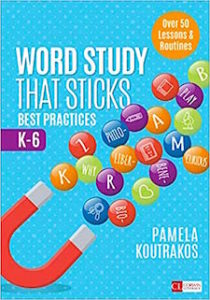
Feature image: Phillip Martin.
Word Study
Word Study
In this section, you will find the following:
A. Instructions for administering the Words Their Way (WTW) spelling test.
B. Video explanation for scoring WTW spelling test using the feature guide.
C. Video of activity that was taught based on the assessment results.
D. Short A Digital Sort template.
E. Editable sort templates that may used for digital sorts.
*Free Words Their Way resources (Spelling Test paper, sorts, and games can be found here).
*Word Study Best Practices
Before I get into sharing some simple word study ideas, let me tell you something: sometimes things are just ironic. I’ve been working with my first grade son on word study patterns that complement his weekly focus in class. For example, last week they did long i using “magic e” so I created some games for him to expose him to all of the ways to make the long i sound. He’s loving it and I’m loving that he’s sorting and reading the patterns. The irony comes from the fact that I have randomly been receiving a notable number of emails asking me about word study and what I do and use. Read below to get some helpful word study ideas for elementary teachers you can use in your classroom.
3 Word Study Ideas for Elementary Teachers
Below are 3 word study ideas for elementary teachers.
1. Use Anchor Charts
The first word study idea on the list is to use anchor charts. Anchor charts are a great tool for teaching word study. They are creating for modeling and serving as a reference tool as students work independently or with partners. Let me share an example of how I use them in my classroom!
Below you can see an anchor chart I used to model how to play the game scattergories.
This activity was perfect when we were also studying data and graphing in math. Ultimately, my students will need to sort data into categories, pose a question, and create a visual to represent their findings. It’s a lot for their little 8-year-old brains to grasp. I always find the “forming categories” to be the most challenging part. We had a breakthrough moment today when I related the concept to sections of the grocery store (produce, canned goods, meats, freezer). Wish I thought of that one sooner!
Anyway, we played Scattergories as a fun word study activity. It was so much fun! The goal was to include words that nobody else had listed. After the time period ended, I manned the chart paper and began taking words from volunteers. A child would say a word. I would write it on the chart and ask, “Does anyone else have that word on their list?”.
If other students had also written the word down on the chart paper, they would give the silent “me too” signal in response. This is a great classroom management strategy!
If the word is on more than one student’s paper, then they would draw a line through it. If a child was the only one to think of the word he would circle it and I added a star on the chart next to the word.
I was so impressed with the words they came up with and we had a great time building our lists!
I recommend you try this word study idea in your classroom!
2. Incorporate Fun Hands On Learning and Games
The second word study idea on the list is to incorporate fun hands on learning experiences.
As elementary teachers, we know how important it is to incorporate hands on learning opportunities and fun games in our classroom. It engages students in their learning and results in better learning outcomes. Of course we should incorporate it into our word study instruction as well.
I’m really focusing on word study as opposed to just “spelling” this year and have been designing some games and activities to go with it. I wanted to come up with some materials that could be used week after week by simply changing out the word patterns. My hope was that they would become familiar with the directions which would make the activities more efficient and beneficial to them.

A word study center that is open-ended, highly engaging, student-driven, reusable, and easily prepped… Does this exist and where can I find it?! Good news: it does! You can find it right here. It is an interactive word study display called BOGGLE. It’s one of my favorite word study games!
This word study activity invites students to explore letters to create words. It is based on the game BOGGLE, which you may have played when you were younger. It serves as a great whole group game, small group activity, and reusable center.
Are you looking for a word study center that is engaging, reusable, and open-ended for differentiation purposes? This BOGGLE center is exactly what you need! Learn all about my Boggle Word Study Game resource! It’s one of my favorite word study ideas for elementary teachers.
Scoop up this Boggle Word Study Game Board!
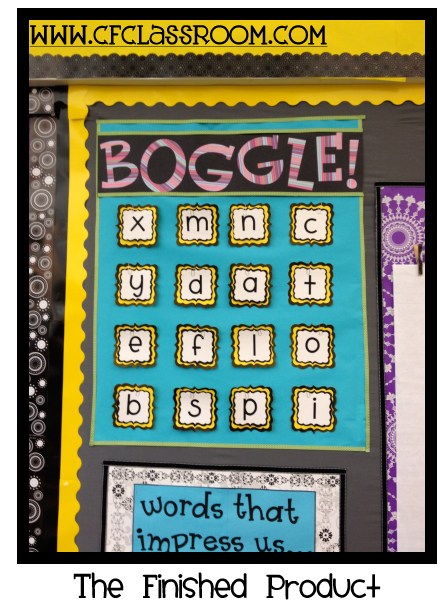
3. Offer Daily Practice
This word study idea may seem obvious, but it’s important to note. Students need to be working on word study skills regularly. One way to offer daily practice is by incorporating a word study center in your literacy centers.
We have a list of spelling words that accompany our reading curriculum (Treasures). I use that as a guide, but differentiate my lists to meet the needs of my learners. This meant I needed to create activities that were open-ended in the sense that the students could be doing the same activity, but with their own personal word lists.
I use these printable spelling activities with spelling lists, word study lists, vocabulary, and content area words. I also use them as homework pages. They are also great to leave when you have a sub. Oh, and if you are a Daily 5er, then these rock for Word Work.
Download these printable spelling activities now!
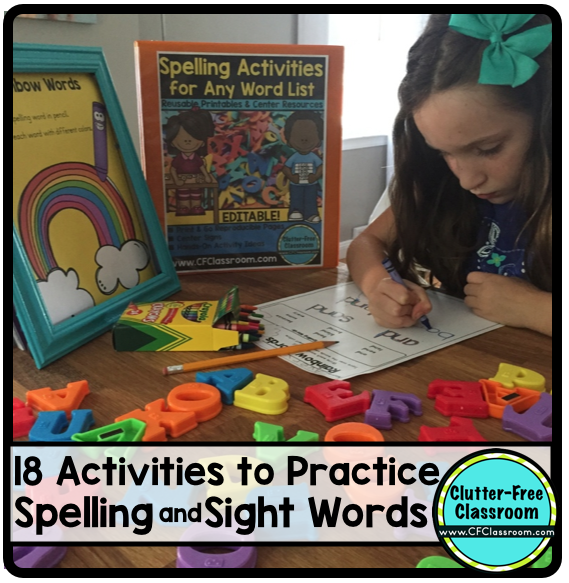
In closing, I hope you found these word study ideas for elementary teachers helpful! If you did, then you may also be interested in these posts and resources:
- The Best Back to School Read Alouds for Elementary Teachers
- How to Read a Picture Book Every Day to Your 1st-3rd Grade Students
- Must-Have First Day of School Picture Books for Elementary Teachers
- How to Use Spelling Activities in Your Elementary Classroom
- How to Use Printable Boggle Board for Elementary Teachers
